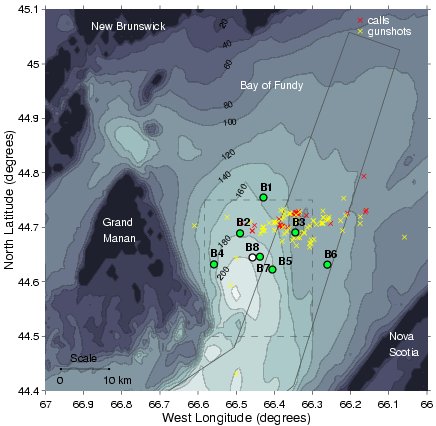
Investigators: Alex E. Hay, Department of Oceanography, Dalhousie University
Francine Desharnais, Defence Research Establishment Atlantic
Christopher Taggart, Department of Oceanography, Dalhousie
The North Atlantic right whale is the most critically endangered large whale species in the world. Annually, 70-85% of the population spends 30-40% of the year in its prime nursery and feeding area in Canadian waters near the mouth of the Bay of Fundy. Based on visual sightings, the distribution of right whales in this habitat overlaps the internationally designated shipping lane. Of the documented right whale deaths (1970-99), ~36% result from ship collisions (Knowlton et al., 1997, Anon. 2000). Some 20-30% of these dead animals were found in the Bay of Fundy. The remainder were found along the eastern seaboard of the US, along the migration route between the Bay of Fundy and the whales' winter habitat off the Florida coast (Knowlton, Pers. Comm.). Action is thus urgently needed on an international level to preserve the population by minimizing the probability of collisions between whales and ships.
Existing right whale location methods (aerial and vessel surveys) are unusable at night and ineffective in fog or low-lying cloud, heavy rain, or in even moderate seas. Thus, the currently available data base on right whale locations contains no information for locations at night, and is highly discontinuous through time. It is also clear that these gaps cannot be filled by visual survey methods, nor are these methods able to provide the real-time whale location information needed for active control of ship traffic.
Two years ago, this group of scientists from Dalhousie University and the Defence Research Establishment Atlantic initiated a project to investigate the potential of passive acoustic systems for tracking right whales in real time on a continuous basis. Feasibility experiments were carried out in July 1999. in August 2000, and in August 2001. By using multiple hydrophones in spatially-distributed, temporally-coherent arrays, individual whale sounds have been located at distances up to 20 km from a given sensor, and right whale sound source spectral density levels (145-190 dB re 1 mPa2/Hz @ 1 m) have been determined. These are, as far as we are aware, the first source level estimates for the Northern right whale (IFAW, 2001). The mean reception rate is several sounds per minute. The 20 km detection range is comparable to the size of the Canadian Right Whale Conservation Area, and to the width of the shipping lane into Saint John. The reception rate of several whale sounds per minute indicates that whale positions can be determined frequently enough to be of value in ship traffic control: that is, useful information on whale locations in advance of a ship navigating these waters could be obtained on time scales of minutes to hours. Thus, these initial studies indicate that a system based on passive-listening techniques has considerable promise for tracking right whales in the Bay of Fundy in real time. The long-term goal of the Dalhousie/DREA Right Whale Project is to develop such a system, incorporating a direct communications link to Marine Communication and Traffic Services (MCTS) in Saint John, NB, so that ship traffic can be directed away from the whale locations. in real time, 24 hours per day. Once in place in the Bay of Fundy, the system would have application to ship-strike reduction elsewhere, either through direct transfer of the technology to other locations, or by providing a right whale observatory for testing other ship-strike reduction technologies.
Because of the widespread concern for the plight of this species, the project is gaining a high profile nationally and internationally, and involves a wide range of opportunities for public outreach and education. We have established links to whale researchers at the Canadian Whale Institute, the Center for Coastal Studies, the New England Aquarium and the Woods Hole Oceanographic Institution, through the Right Whale Research Consortium. The project has attracted widespread interest in the media, from local newspapers to television and radio, both within and outside Canada, including Radio Canada International, the Weather Network, and U.S. National Public Radio.
We envisage an underwater acoustic observation network consisting of directional hydrophone arrays connected to a shore-based central processing node accessible online. The system would comprise an array of underwater hydrophone nodes, each with a data acquisition and processing computer and ancillary sensors for monitoring oceanographic conditions (temperature, pressure, salinity, currents and zooplankton concentrations). Zooplankton are the food resource for these animals, and the zooplankton measurements would address the variability in this food supply, which seems to be related to reproductive success. The other oceanographic measurements would interface with and represent an extension of the Gulf of Maine Ocean Observing System (GoMOOS) being developed by US scientists.
The tracking system will be developed in three stages. In the first stage, radio-telemetering drifting nodes will be deployed from a mother ship carrying the central node, to conduct 1-2 week system trials. The longer-term vision is to deploy the listening nodes on the seabed, connected to shore via fibre-optic cable. This approach would avoid the many hazards and difficulties associated with moored instrument packages attached to surface flotation in the strong tidal currents in the Bay of Fundy. In the third stage of the project, a predictive capability would be implemented and incorporated into the ship-strike avoidance: whale locations would be forecast several hours into the future, based on measured positions and trajectories, and tidal current predictions from a numerical tidal circulation model.
IFAW, 2001. Report of the Workshop on Right Whale Acoustics: Practical Applications in Conservation. (eds. Gillespie, D., and Leaper,R.) International Fund for Animal Welfare, Yarmouth Port, MA. 27pp.
Knowlton, A., Kraus, S., Meck, D., and Mooney-Sues, M. 1997. Shipping/Right Whale Workshop, report 97-3, The New England Aquarium, Boston, USA.


This page last updated November 21, 2001.
Back to Hay